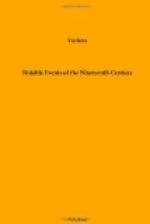In any event, such has been the history of recorded language. The early races began as the mother begins with her children; that is, with oral speech. But at a certain stage this method was abandoned, and teachers came with pictorial symbols of words. They invented visible characters to signify words, syllables, sounds. Thus came alphabetical writing, syllabic writing, verbal writing, into the world. Ever afterward the children of men learned speech first from their parents, by oral utterance; but afterward by means of the pictorial signs in which human language was recorded.
This method became habitual. The eye was made to be the servant of the intellect in learning nearly all that was to be gained from the wisdom of the past. It was by the tedious way of crooked marks signifying words that ideas were henceforth gleaned out of human lore by all who would learn aught from the recorded wisdom of mankind. And yet there never was anything essentially absurd or insurmountable in the invention of a method of recording speech in audible instead of visible symbols.
The phonograph came swiftly after the telephone. The new instrument is in a sense the complement of its predecessor. Both inventions are based upon the same principle in science. The discovery that every sound has its physical equivalent in a wave or agitation which affects the particles of matter composing the material through which the sound is transmitted led almost inevitably to the other discovery of catching and retaining that physical equivalent or wave in the surface of some body, and to the reproduction of the original sound therefrom.
Such is the fundamental principle of the interesting but, thus far, little useful instrument known as the phonograph. The same was invented by Thomas A. Edison, of Menlo Park, in the year 1877. The instrument differs considerably in structure and purpose from the Vibrograph and Phonautograph which preceded it. The latter two instruments were made simply to write sound vibrations; the former, to reproduce audibly the sounds themselves.
The phonograph consists of three principal parts,—the sender or funnel-shaped tube, with its open mouth-piece standing toward the operator; the diaphragm and stylus connected therewith, which receives the sound spoken into the tube; and thirdly, the revolving cylinder, with its sheet-coating of tin-foil laid over the surface of a spiral groove to receive the indentations of the point of the stylus. The mode of operation is very simple. The cylinder is revolved; and the point of the stylus, when there is no sound agitation in the funnel or mouth-piece, makes a smooth, continuous depression in the tin-foil over the spiral groove. But when any sound is thrown into the mouth-piece the iron disk or diaphragm is agitated; this agitation is carried through the stylus and written in irregular marks, dots, and peculiar figures in the tin-foil over the groove.




